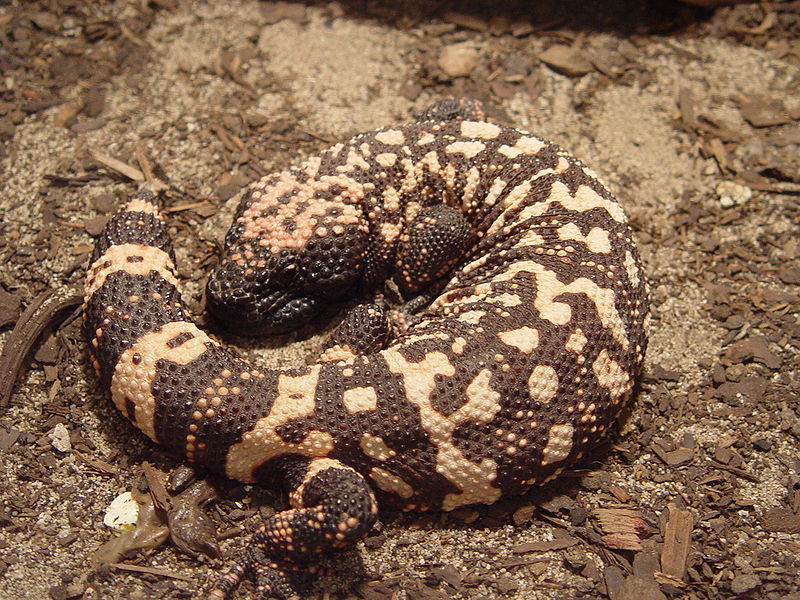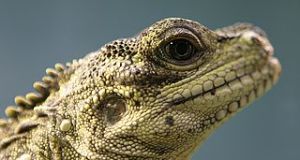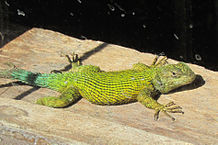
Every so often I like to cover a species that, while not recommended as a pet, is well worth a closer look. One such lizard that I have had the good fortune of working with is endemic to North America, the strikingly-marked Gila Monster.
Note: Gila Monsters are bred in captivity and sometimes appear for sale in the pet trade. Please do not let your interest in these admittedly fascinating creatures lead you to purchase one. They are venomous, and, despite recurring rumors to the contrary, have caused human fatalities. Gilas are considered by many to be somewhat docile and slow moving. Having long cared for them as a zoo herpetologist, I can assure you that this is not so. They are often inactive, but can bite with amazing speed – and, in contrast to many snakes, there is no preparatory coil or other movement to warn of their intentions. If anything, their generally calm demeanor can lull one into a sense of false security – indeed, Gila bites are among those most frequently suffered (and covered up!) by zoo keepers. Observe them in public collections and the wild, but please leave captive care to zoos.
Physical Description
This stoutly built creature is the USA’s heaviest native lizard, outweighed only by Florida’s introduced Green Iguanas and Nile Monitors.
The scales, underlain by boney plates known as osteoderms, are bead-like in appearance. The body is marked in widely varying patterns of pink, black yellow and orange blotches. The blunt tail serves as a food-storage vessel – during lean times it may lose 20% or more of its mass. Adult size ranges from 9 to 24 inches.
Range
Two subspecies, the Reticulate Gila Monster and the Banded, are recognized. They are found in western, central and southern Arizona and adjacent New Mexico, southwestern Utah through Nevada and from southwestern California to Sinaloa in northern Mexico.
Habitat
Although typically thought of as a desert-dwelling species, Gila Monsters do not live in overly dry, central desert areas. Rather, they frequent arid desert fringes and habitats that are referred to as “succulent or vegetated deserts” – areas that usually support a heavy growth of succulent plants, cacti, grasses and shrubs. They may also be found in semi-arid plains and rocky foothills, lightly wooded thickets and about farms, usually near streams, springs or other sources of moisture. Gilas sometimes enter oak forests and in Sinaloa, Mexico, inhabit the lower slopes of mountains and nearby beaches.
Gilas may forage above-ground but are otherwise largely fossorial. They occupy burrows dug by gophers and other mammals or those of their own making, abandoned woodrat nests and cavities below large rocks.
Despite the arid climate prevalent in their range, Gila Monsters favor areas of high humidity and spend the vast majority of their time in fairly moist underground retreats. When kept in dry zoo exhibits, Gilas will soak in water bowls for hours on end.
Gila Monsters are diurnal in the springtime but become largely nocturnal as summer progresses. During the hottest parts of the year they generally appear above ground only after rains.
Status in the Wild
Gila Monster populations are declining due to habitat loss and, in some cases, collection for the pet trade. They are protected by law in all states within their range, are listed on CITES Appendix II and classified as Near Threatened by the IUCN.
Diet
Gilas feed on slow-moving animals – most commonly young mammals still in the nest, i.e. ground squirrels, kangaroo rats, pocket gophers, rabbits and cactus mice. They also take the eggs and chicks of doves, quail and other ground-nesting birds, lizards and their eggs, tortoise eggs, locusts and other large insects and carrion.
These lizards are well-adapted to a harsh environment in which food is often scarce. They gorge when food is available, consuming up to 50% of their bodyweight, and in some areas eat but 3-4 large meals annually.
Reproduction
Mating occurs in April and June, with 3-12 eggs being laid from July through August. The eggs are buried in the sand, usually in a location exposed to full sun. The eggs do not hatch until the following May – 10 months after being laid. This long incubation period is a function of seasonality within the Gila’s range…artificially incubated eggs have hatched in as few as 30 days.
Longevity
Captive longevity exceeds 28 years; unknown in the wild.
Lizard Venoms
The Beaded Lizard, H. horridum, 4 subspecies of which dwell in Mexico and Guatemala, is a close relative of the Gila and the only other member of the family Helodermatidae. These 2 species were, until recently, considered to be the only venomous lizards (please see below). In contrast to venomous snakes, the venom glands of Gila Monsters and Beaded Lizards are in the lower jaw and the teeth are grooved rather than hollow. Venom flows into the mouth through ducts that open between the teeth and gums. In order to insure the venom’s introduction into a prey animal or enemy, both lizards retain a firm grasp when biting.
In 2005, researchers at Australia’s Melbourne University discovered that the Bearded Dragon, Pagona vitticeps, produces a mild venom (other Agamids are being studied). Several monitor lizards, including the Komodo Dragon, Varanus komodoensis and the Lace Monitors V. varius, were also found to produce venoms of varying strengths. Studies of Lace Monitor venom have revealed that it causes the lizard’s prey to rapidly loss consciousness by affecting the blood’s pressure and clotting ability. This venom is likely the source of the strong reaction, previously attributed to oral bacteria, that is often associated with bites inflicted by monitor lizards upon people.
Miscellaneous
A synthetic version of a chemical found in the saliva of the Gila Monster is the basis of an important medication used to treat Diabetes Type II.
The species name, suspectum, was coined in 1869 by renowned herpetologist and paleontologist Edward Drinker Cope – upon noting the Gila’s grooved teeth, he “suspected” that it was venomous! The genus name, Gila, is taken from the Gila River Basin in Arizona.
You can read more about the Gila Monster and the reptiles and amphibians that share its habitat at the web site of the Arizona Sonora Desert Museum:
http://www.desertmuseum.org/books/nhsd_gila.php
Image referenced from Wikipedia Commons at http://en.wikipedia.org/wiki/Image:Gila_monster2.JPG and posted by Blueag9
 That Reptile Blog – Reptile, Amphibian and Exotic Pet Care and Information
That Reptile Blog – Reptile, Amphibian and Exotic Pet Care and Information




You speak of deaths caused by these animals. I would like to read the literature that proves this. Would you please either document on your blogg or send me the reference, I would appreciate that.
Thank you
Hello Kerri,
Thank you for your comment and interest in our blog.
The incidents I referred to were reported in back issues of The Journal of Herpetology and Herpetoligica. I came across these in the course of general reading/perusing during my years working at the Bronx Zoo (the library has issues dating back almost 100 years). Unfortunately, I did not take notes and those journals are not readily accessible via the inter net.
Most of my own books and journals give anecdotal references to fatalities, but a specific incident is reported at:
Treadwell, G.A. 1888. Human fatality allegedly from the bite of Heloderma suspectum. Proc. Zool. London 1888:266
Again not a readily available source, but I do recall reading about the case, which was referenced in a later publication. The “alleged” was inserted due to the possible influence of alcohol (see below).
The good source of information as to the actual properties that render the venom lethal (drawn from studies of the closely related beaded lizard) is:
Komori, Y. T. Nikai and H. Susihara. 1988. Purification and characterization of lethal toxin from the venom of Heloderma horridum horridum. Biochemical and Biophysical Communications. 154(2): 613-619
Anecdotal accounts include:
Sola, R.D.(ed). American Wild Life. 1940: The City of New York, New York. “It (Gila monster venom) is not believed to be always fatal to man, but a side show performer who allowed himself to be bitten by a Gila for the delectation of a jaded public finally died of poisoning after carrying on his act for many years).
Mattison, C. Lizards of the World. 1989: Facts on File, New York. “Serious bites, in which the lizard has an opportunity to chew on the victim, are potentially fatal to humans, although reports of fatalities are rare”.
Lidiky, C.E. Biochemistry of Helodermid Venom. 1997: C. Lidiky and K. Stone. “There have been cases of fatalities, but alcohol intoxication seems to have been a major factor”. (Note: in the majority of the venomous snake bite emergencies to which I have responded, alcohol was nearly always a factor!).
I have written to a colleague who may have references that will prove more useful to you. I’ll be back in touch as soon as I have more information.
Thanks again for your interest.
Best regards,
Frank
Hello Kerri,
Referring to your question on deaths caused by Gila monster bites, I just heard back from a colleague and thought I’d pass along some additional information.
The most comprehensive reference on Gila monsters is The Biology of Gila Monsters and Beaded Lizards, by Daniel Beck (University of California Press, 2005). Interestingly, that book mentions the case of the showman that I referenced in my last note. Apparently he did expire, largely because he was given adrenalin and digitalis by the attending physician to “speed up his heart” (which, of course, also “sped up” the unfortunate fellow’s death). As with nearly every other case reported (and about 95% of the venomous snake bites to which I responded), the victim was drunk.
The book cites Weldon Woodson’s review of Gila monster bite case histories as the most thorough treatment of the subject. Most of the information therein was gleaned from newspaper reports as opposed to peer-reviewed articles, and details are often sketchy.
The most reliably documented fatality is stated to have occurred in 1930. As reported by the Arizona Republic News, a “very drunk” pool hall operator in Casa Grande, Arizona was bitten on the thumb while teasing a Gila monster (always best to refrain from teasing animals, venomous or otherwise, when you are drunk!) and died 2 hours thereafter.
Following is a summary of Mr. Woodson’s findings, again drawn largely from newspaper articles:
From 1882 -1939 – 15 deaths from 47 bites, a 32% mortality rate.
As of 1947 – 29 deaths from 136 bites, a 21% mortality rate.
As of 1950 – 23 deaths from 158 bites, a 14.6% mortality rate.
The book’s author reviewed 10 cases reported in medical journals since 1981, none of which resulted in fatalities. All involved pet-keepers (drunk or otherwise) or people trying to capture (while drunk, perhaps) the lizards. One nearly fatal bite occurred in 1986, when a woman hid a Gila monster beneath her blouse and then entered a tavern (I’m guessing she had been in the tavern previously!), intending to startle her boyfriend. The lizard latched onto her abdomen – startling both captor and boyfriend.
The author concludes by sating that, in his opinion, a Gila monster bite is unlikely to be fatal to any “…person in good physical health given appropriate treatment.”
Thanks again for your interest.
Best regards,
Frank Indiviglio